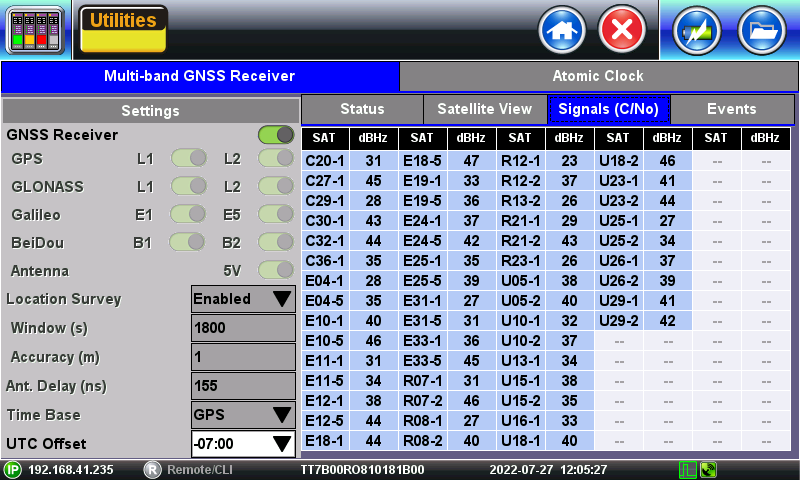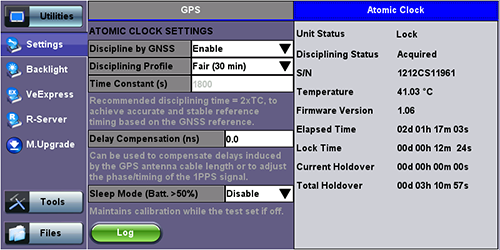High Precision Clock Sources
GPS/GNSS Receiver (HW Option)
The optional high-sensitivity GPS/GNSS modules (built-in) provide accurate Phase alignment and Coordinated Universal Time (UTC) synchronization to the test set, in the form of internal pulse-per-second (1PPS) clock synchronized to the standard second and timestamps. This is used to assure that two or more geographically-distributed test sets have the exact same time and can calculate delays. One example is the One-Way-Delay (Latency) tests used to identify asymmetry between each direction of a link.

The GPS Time of Day (ToD) can also be used to precisely set the local date and time in the test set, using the Sync ToD function, which will apply the local time zone correction before applying it to the test set system real time clock. This timestamp is used for reports and events, but not for time-sensitive testing.
GPS ToD is also used in One-Way-Delay (OWD) measurements and time is applied directly to each test set before the test starts, so they all have accurate time.
The GPS/GNSS receivers can be turned OFF if not used, to save battery power.
A satellite table, showing satellites in view, satellites being used and signal to noise density, is provided for information only, so the correct antenna installation can be verified. Geographical coordinates are also provided for information only and it could be used in the future to geo-tag some position-sensitive results. The GPS/GNSS antenna must have direct view to the sky. At least four satellites with SNR of 34 dB-Hz or better are recommended for accurate testing.
Atomic Clock (HW Option – Factory installed)
The optional built-in chip-scale Atomic Clock module provides a highly stable clock source to the test set, in the form of a highly accurate and stable internal 10 MHz frequency and 1PPS timing references. These references can be used to drive PDH/DSn, SDH/SONET/OTN or SyncE Master transmitters or be used as a reference for Frequency, Phase, Time Error, and Wander measurements. Their main function is to serve as a precision reference to measure wander (clock stability), even in places where there is no reference clock signals available that can be traced back to a Primary Reference Clock (PRC) or Primary Reference Time Clock (PRTC).

GPS-Disciplined Clock
When GPS/GNSS and Atomic Clock options are installed and enabled, the Atomic Clock uses the GPS signal to calibrate its frequency (10 MHz) and timing references (1PPS), to improve their accuracy and stability. The Atomic Clock 1PPS phase is disciplined to the UTC to align it with the standard second. The raising edge of the 1PPS pulse indicates the beginning of a new second all over the world.
Disciplining can be disabled or enabled. When disabled, the atomic clock runs at its natural frequency (free-running), providing a very stable frequency source. When disciplining is Enabled, the atomic clock will use the GPS/GNSS accuracy to correct its frequency and align its phase.
The Disciplining Profile sets a time window the atomic clock's dynamic control loop, to filter any short term frequency and phase variations coming from the GPS/GNSS receiver, this is called Time Constant. The longer the time constant, the more accurate and stable the atomic clock output can be. The Disciplining Profile field provide suggested options for the minimum disciplining times and sets the equivalent Time Constant. The selection varies with applications and location, so some experimentation may be required by users to select their own default value. For quick field Wander or Phase measurements a disciplining time of ≥ 60 minutes (TC ≥ 1800 seconds) is recommended. Users can also enter a customized time constant in seconds.
Holdover
In case of GPS/GNSS signal loss (e.g. indoor testing) the high stability of the Atomic Clock can maintain synchronization for a few hours allowing users to perform quick Wander and Absolute Phase Error in conditions that were not possible before. This is called holdover mode.
Delay Compensation can be used to perform minor adjustments to the 1PPS phase, to align it to a specific reference or to compensate for short cable delays.
When enabled, the low power Sleep Mode keeps the atomic clock powered up when the test set is turned off. This way it maintains its last calibration by drawing little current from the batteries. In this state, the test set will only cut the power to the atomic clock if the battery charge reaches a level less than 50% of charge, to conserve battery. The Elapsed Time counts the time since its first initialization, including the time the test set has been off. If disabled, the atomic clock is shut down with the test set and will require full initialization the next time it is powered up.
Warm Up Times
All precision reference sources require a “warm up” time to achieve high accuracy and stability. The warm up term is being used loosely because it is not just about attaining the right temperature. It also includes disciplining of a local oscillator, negotiating and stabilizing a clock through protocol messages, etc. Each of the tasks involved takes time to stabilize before it can be used for testing.
Operational Temperature
It is still a major player in the warm-up waiting time and it all depends on the ambient temperature and the initial temperature of the test set. For example, a test set left in the trunk of a car in a winter night will take longer to reach operational temperature.
Atomic Clock Warm Up
If fitted with a chip-scale atomic clock, they are housed in a miniature oven to maintain its internal temperature constant in spite variations in ambient temperatures and it can take up to five minutes to warm up and should not be used until its status shows “Locked”. The atomic clock temperature and status can be monitored at \Utilities \Settings \More \High Precision Clock Source \Atomic Clock. The chip-scale atomic clock is oven-controlled and temperature-compensated to minimize the effects of ambient temperature variations.
Beside temperature, users must be aware of other factors that require time to settle, before accurate measurements can be made.
GPS Lock
The time to get an stable clock output varies depending on the conditions, antenna type and installation, sky visibility and whether or not the test set has changed position. Using the test set for the first time on a new site (different geographical position) would increment the time to its first satellite lock. Users can follow the different stages (Searching, Sync 1PPS, and Lock) by checking the GPS status GUI at >Utilities >Settings >More >High Precision Clock Source >GPS.
Disciplining Time
Disciplining the atomic clock means using the accurate GPS timing signal to correct or align the atomic clock output signals. GPS are known for their high accuracy as they are traceable to the universal time standard (UTC). Atomic Clocks are known for their great stability. So, the combination of GPS + Atomic Clock = Highly Accurate and Stable clock source. Achieving such levels of precision takes time. The total time to stable output depends on the precision required. The disciplining time can be programmed in the Atomic Clock settings and users must add it to the total “warm-up” time, before starting measurements.
Precision Timing Protocol
PTP, like IEEE 1588v2, require some time for the two ends (master and slave) to agree on the current time. This protocol “warm-up” time is dependent on the link conditions (traffic, latency, delay variations, PTP settings, etc.). Tests shall not be started until the protocol has stabilized and the recovered clock has achieved its maximum accuracy and stability. This is sometimes referred as “Convergence” or “Sync PDV” convergence. Users can use the long tail of the 1588v2 Sync PDV graph as an indication the PTP has reached synchronous state.